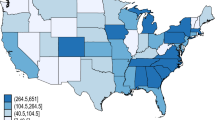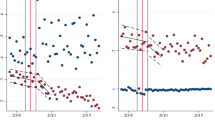Abstract
Using a unique facility-level dataset from Michigan, we examine the effect of environmental auditing on manufacturing facilities’ long-term compliance with U.S. hazardous waste regulations. We also investigate the factors that affect facilities’ decisions to conduct environmental audits and whether auditing in turn affects the probability of regulatory inspections. We account for the potential endogeneity of our audit measure and the censoring of our compliance measure using a censored trivariate probit, which we estimate using simulated maximum likelihood. We find that larger facilities and those subject to more stringent regulations are more likely to audit; facilities with poor compliance records are less likely to audit. However, we find no significant long-run impact of auditing on the probability of a regulatory inspection or compliance among these Michigan manufacturing facilities.
Similar content being viewed by others
References
Anton W., Deltas G., Khanna M. (2004) Incentives for environmental self-regulation and implications for environmental performance. Journal of Environmental Economics and Management 48: 632–654
Cappellari, L., & Jenkins, S.P. (2006). Calculation of multivariate normal probabilities by simulation, with applications to maximum simulated likelihood estimation. Discussion Papers of DIW Berlin, German Institute for Economic Research.
Dasgupta S., Wheeler D. (2000) What improves environmental compliance? Evidence from Mexican industry. Journal of Environmental Economics and Management 39: 39–66
Evans M.F., Gilpatric S.M., McKee M., Vossler C.A. (2008) Managerial incentives for compliance with environmental information disclosure programs. In: Cherry T., Shogren J., Kroll S. (eds) Experimental methods, environmental economics. Routledge, UK
Feeley, M. S. (1995, July 13). Dirty secrets: California moves to protect businesses that conduct environmental self-audits. Los Angeles Daily Journal.
Friesen L. (2006) The social welfare implications of industry self-auditing. Journal of Environmental Economics and Management 51: 280–294
Gamper-Rabindran S. (2006) Did the EPA’s voluntary industrial toxics program reduce emissions? A GIS analysis of distributional impacts and by-media analysis of substitution. Journal of Environmental Economics and Management 52: 391–410
Harrington W. (1988) Enforcement leverage when penalties are restricted. Journal of Public Economics 37: 29–53
Innes R., Sam A. (2008) Voluntary pollution reductions and the enforcement of environmental law: An empirical study of the 33/50 program. Journal of Law and Economics 51: 271–296
Khanna M., Anton W. R. Q. (2002) Corporate environmental management: Regulatory and market-based incentives. Land Economics 78(4): 539–558
Khanna M., Brouhle K. (2008) Effectiveness of voluntary environmental initiatives. In: Delmas M., Young O. (eds) Governing the environment: Interdisciplinary perspectives. Cambridge University Press, Cambridge
Khanna M., Damon L. A. (1999) EPA’s voluntary 33/50 program: Impact on toxic releases and economic performance of firms. Journal of Environmental Economics and Management 37: 1–25
Khanna M., Widyawati D. (2011) Fostering regulatory compliance: The role of environmental self-auditing and audit policies. Review of Law and Economics 7: 129–163
King A., Lennox M. (2000) Industry self-regulation without sanctions: The chemical industry’s responsible care program. Academy of Management Journal 43: 698–716
Michigan Department of Environmental Quality (DEQ). (2006). Environmental audit privilege and immunity: Update with 1997 amendments. http://www.michigan.gov/documents/deq/deq-ess-audit-slfaudit_274862_7.pdf
Mishra B. K., Newman D. P., Stinson C. H. (1997) Environmental regulations and incentives for compliance audits. Journal of Accounting and Public Policy 16: 187–214
Pfaff A. S. P., Sanchirico C. W. (2000) Environmental self-auditing: Setting the proper incentives for discovery and correction of environmental harm. Journal of Law, Economics, and Organization 16: 189–208
Potoski M., Prakash A. (2005) Green clubs and voluntary governance: ISO 14001 and firms’ regulatory compliance. American Journal of Political Science 49: 235–248
Sam A. (2010) Impact Of government-sponsored pollution prevention practices on environmental compliance and enforcement: Evidence from a sample of US manufacturing facilities. Journal of Regulatory Economics 37: 266–286
Sam A. G., Khanna M., Innes R. (2009) Voluntary pollution reduction programs, environmental management, and environmental performance: An empirical study. Land Economics 85(4): 692–711
Stafford, S. L. (2005). Does self-policing help the environment? EPA’s audit policy and hazardous waste compliance. Vermont Journal of Environmental Law, 6.
Stafford, S. L. (2006). Rational or confused polluters? Evidence from hazardous waste compliance. Contributions to Economic Analysis and Policy, 5: Article 21.
Stafford S. L. (2007) Should you turn yourself in? The consequences of environmental self-policing. Journal of Policy Analysis and Management 26: 305–326
Stafford S. L. (2008) Self-policing in a targeted enforcement regime. Southern Economic Journal 74: 934–951
Stern S. (1997) Simulation-based estimation. Journal of Economic Literature 35: 2006–2039
Train K. (2003) Discrete choice methods with simulation. Cambridge University Press, Cambridge
Uchida T., Ferraro P. J. (2007) Voluntary development of environmental management systems: Motivations and regulatory implications. Journal of Regulatory Economics 32: 37–65
U.S. Environmental Protection Agency (EPA). (1997). EPA strategic plan. EPA/190-R-97-002.
U.S. Environmental Protection Agency (EPA). (1999). EPA/CMA root cause analysis pilot project: An industry survey.
U.S. General Accounting Office (GAO). (1995). Environmental auditing: A useful tool that can improve environmental performance and reduce cost savings. GAO/RCED 95–37.
Videras J., Alberini A. (2000) The appeal of voluntary environmental programs: Which firms participate and why?. Contemporary Economic Policy 18: 449–461
Vidovic M., Khanna N. (2007) Can voluntary pollution prevention programs fulfill their promises? Further evidence from the EPA’s 33/50 program. Journal of Environmental Economics and Management 53: 180–195
Author information
Authors and Affiliations
Corresponding author
Rights and permissions
About this article
Cite this article
Evans, M.F., Liu, L. & Stafford, S.L. Do environmental audits improve long-term compliance? Evidence from manufacturing facilities in Michigan. J Regul Econ 40, 279–302 (2011). https://doi.org/10.1007/s11149-011-9163-2
Published:
Issue Date:
DOI: https://doi.org/10.1007/s11149-011-9163-2




